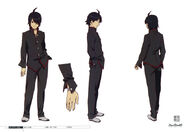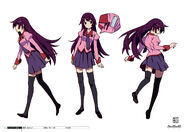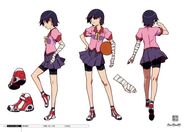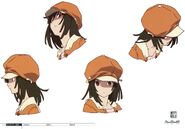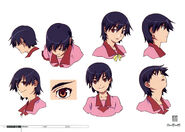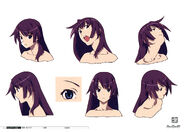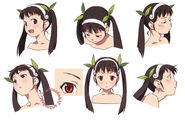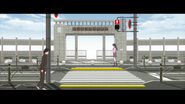Bakemonogatari (化物語) is the anime adaptation of Bakemonogatari, the first part of the Monogatari Series light novels. It is the first adaptation from Japanese animation studio Shaft. It is directed by Akiyuki Shinbo and Tatsuya Oishi, and written by Fuyashi Tō.
The series started airing on July 3rd, 2009 in Japan. It was scheduled to be 15 episodes long but broadcast only the first 12 episodes on television. The remaining three episodes were distributed on the official website, the final episode airing on June 25, 2010.
Plot
- See also: Bakemonogatari#Plot
The Bakemonogatari anime series follows the plot of the light novels, which chronicle the life of a high school boy named Koyomi Araragi, who after being bitten by a vampire was able to return to being human with the help of a man named Meme Oshino, although some vampire traits remained in his body.
Each of the five stories covering the Bakemonogatari light novels are adapted into fifteen episodes, with Hitagi Crab and Nadeko Snake adapted to two episodes, Mayoi Snail and Suruga Monkey into three episodes, and Tsubasa Cat into five episodes (three of which are released in original net animation format). Despite this, the arc-centered approach still covers a central plot which goes through all five arcs.
Episode List
| No. | Title | Endcard | Original Air Date |
|---|---|---|---|
| 1 | Hitagi Crab, Part 1 | Vofan | July 3, 2009 |
| 2 | Hitagi Crab, Part 2 | Iruka Shiomiya | July 10, 2009 |
| 3 | Mayoi Snail, Part 1 | Jin Kobayashi | July 17, 2009 |
| 4 | Mayoi Snail, Part 2 | Miki Yoshikawa | July 24, 2009 |
| 5 | Mayoi Snail, Part 3 | Hiro Mashima | July 31, 2009 |
| 6 | Suruga Monkey, Part 1 | Seiko Erisawa | August 08, 2009 |
| 7 | Suruga Monkey, Part 2 | Koge-Donbo | August 21, 2009 |
| 8 | Suruga Monkey, Part 3 | Hekiru Hikawa | August 28, 2009 |
| 9 | Nadeko Snake, Part 1 | Machiko Kyou | September 4, 2009 |
| 10 | Nadeko Snake, Part 2 | Akiman | September 11, 2009 |
| 11 | Tsubasa Cat, Part 1 | Daisuke Nishijima | September 18, 2009 |
| 12 | Tsubasa Cat, Part 2 | Hajime Ueda | September 25, 2009 |
| 13 | Tsubasa Cat, Part 3 | Rin Nadeshiko | November 3, 2009 (ONA) |
| 14 | Tsubasa Cat, Part 4 | Hikaru Nakamura | November 10, 2009 (ONA) |
| 15 | Tsubasa Cat, Part 5 | Akio Watanabe | November 17, 2009 (ONA) |
Introduced Characters
- Koyomi Araragi
- Tsubasa Hanekawa
- Meme Oshino
- Shinobu Oshino
- Hitagi Senjougahara
- Mayoi Hachikuji
- Suruga Kanbaru
- Nadeko Sengoku
- Black Hanekawa
- Karen Araragi
- Tsukihi Araragi
Presentation
The series features character designs by Akio Watanabe based on VOFAN's original concepts. Bakemonogatari was made before the company had gained a large following, and as such had a notably lower budget than their modern works.
As the first animated adaptation in the series, Bakemonogatari set the president for the style and techniques used in all later adaptations. It not only used many of the unorthodox direction techniques of Shaft's creative head, Akiyuki Shinbo, but many new ones as well with influence from director Tatsuya Oishi. Many of these techniques have consistently been used throughout all proceeding adaptations, albeit evolved slightly. The following explains many of these techniques in detail as they were used in this first adaptation.
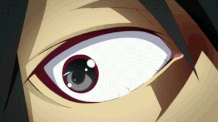
Eye Fixation
Eyes are constantly zoomed into and shown close up, especially to show emotion.
Screen Flashes

Commonly, text is flashed one the screen. Sometimes these are colored sheets showing animation numbers, kanji, words related to scenes, or quotes from the novel. It's speculated that these screens were originally used as means to compensate for low budget while also working as a unique technique.
Alternate Color Palettes / Intense Lighting Effects

Senjougahara with black hair and an altered color scheme to her uniform.
Characters and their clothing occasionally change color schemes in different scenes. Different shades of lighting are also used frequently.
Abandoned Locations / Main Character Bias
Most scenes take place in architecturally interesting locations that also contrast the character designs. Commonly, only 2 - 3 characters are ever seen on screen, making locations appear abandoned and empty. Background characters are nonexistent, and one time side characters have their faces obscured.
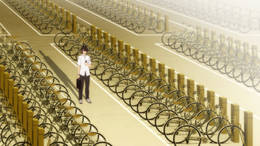
It's not usually made entirely clear, but certain scenes, such as those showing characters sitting in classrooms, seem to imply that there are cases in which background characters are there, they just aren't shown. Supposedly, this technique was used to represent Koyomi and his indifference towards those around him.
Widescreen Aspect Ratio
Sometimes scenes are depicted with a cinematic ratio.
Real-life Footage & Imagery
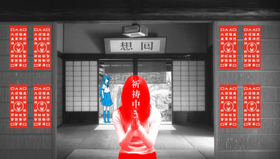
Real life photos and footage is used quite sparingly in multiple, brief instances. For instance, a close up of a body part could show a real life image in its place or backdrop of the sky could use real footage. Some scenes depict characters with pictures of real people.
Real life material is almost entirely absent in all the adaptations proceeding Bakemonogatari except Kizumonogatari, implying its likely a technique heavily related to director Tatsuya Oishi.
Music
The music for the series is produced by Satoru Kosaki under the supervision of Yota Tsuruoka. Kousaki also composed the opening theme songs for each of the five story arcs of the anime series, with meg rock writing the lyrics to the songs. The ending theme song, entitled "Kimi no Shiranai Monogatari", is produced by Supercell and performed by Nagi (formerly known as Gazelle in Nico Nico Douga).
The five theme songs featured in the anime series were initially released as singles, with the single for "sugar sweet nightmare" bundled with selected background music tracks used in the series. A two-disc soundtrack album launched on December 21, 2011, which includes the opening and ending theme songs and all of the background music used in the anime series.
Opening Theme Songs
- staple stable - Chiwa Saito (ep 1-2, 12)
- Kaerimichi - Emiri Katou (ep 3-5)
- Ambivalent World - Miyuki Sawashiro (ep 6-8)
- Ren'ai Circulation - Kana Hanazawa (ep 9-10)
- sugar sweet nightmare - Yui Horie (ep 11, 13-15)
Closing Theme Songs
- Kimi no Shiranai Monogatari - Supercell
Blu-ray Changes
Studio Shaft is infamous for making major visual improvements to their blu-ray releases, especially in the late 2000's when their budget was significantly lower. While blu-ray alterations are still made in modern releases, the anime adaption of Bakemonogatari has the second highest number of them in the series with 2292 total, just behind Second Season with 2840. It should however be noted that Bakemonogatari has the highest average of changes per episode, with 176 compared to Second Season's 123.[1][2]
Changes range from minimal color alterations to entire character redraws that fix inconsistencies in character design. Some background art used in the TV version were actual real life photos which were later drawn in the blu-ray release.







Comparisons with the TV version on the left, Blu-ray on the right, and a combined image on the far right.
The two episodes of the Nadeko Snake arc in particular had the most amount of changes with over 800 total. One portion that was supposed to show Nadeko being attacked by the Jagirinawa merely displayed an image of the night sky. In the blu-ray, the actual scene was depicted in place of the sky image.



The few images that did display the intended scene featured very minimal animation and Nadeko shivering instead of squirming.
The blu-ray version of Bakemonogatari is the only blu-ray version of the series that is available on legal streaming sites. All other parts available are their original TV versions.
Gallery
External Links


